Book contents
- Frontmatter
- Contents
- List of contributors
- Preface
- Acknowledgements
- Abbreviations
- I The neurochemistry of the states of sleep and wakefulness
- II The influence of neurotransmitters on sleep and wakefulness
- 4 Gamma-aminobutyric acid and the regulation of paradoxical, or rapid eye movement, sleep
- 5 Acetylcholine modulates sleep and wakefulness: a synaptic perspective
- 6 Histamine in the control of sleep–wakefulness
- 7 Dopamine in behavioral state control
- 8 Glutamate neurotransmission and sleep
- 9 Serotonin and sleep–wake regulation
- III Changing perspectives
- Index
- Plate section
5 - Acetylcholine modulates sleep and wakefulness: a synaptic perspective
from II - The influence of neurotransmitters on sleep and wakefulness
Published online by Cambridge University Press: 23 October 2009
- Frontmatter
- Contents
- List of contributors
- Preface
- Acknowledgements
- Abbreviations
- I The neurochemistry of the states of sleep and wakefulness
- II The influence of neurotransmitters on sleep and wakefulness
- 4 Gamma-aminobutyric acid and the regulation of paradoxical, or rapid eye movement, sleep
- 5 Acetylcholine modulates sleep and wakefulness: a synaptic perspective
- 6 Histamine in the control of sleep–wakefulness
- 7 Dopamine in behavioral state control
- 8 Glutamate neurotransmission and sleep
- 9 Serotonin and sleep–wake regulation
- III Changing perspectives
- Index
- Plate section
Summary
Seventy years ago Otto Loewi and Henry Dale shared the 1936 Nobel Prize for the discovery that acetylcholine (ACh) is a neurotransmitter. Loewi's Nobel Lecture provided the following historical context for their discovery (Loewi, 1936): “Up until the year 1921 it was not known how the stimulation of a nerve influenced the effector organ's function, in other words, in what way the stimulation was transmitted to the effector organ from the nerve-ending.” The significance of Loewi's and Dale's discovery is emphasized by the profound relevance of ACh for sensorimotor, autonomic, and arousal state control. At all neuromuscular junctions ACh is the transmitter. For the autonomic nervous system, all preganglionic sympathetic and parasympathetic nerves use ACh, as do postganglionic fibers of the parasympathetic nervous system. In the context of the present volume, the effector organ of sleep is the brain. Therefore, this chapter focuses on the role of cholinergic “nerve endings” through which “the effector organ” generates states of sleep and wakefulness. This chapter uses Loewi's synaptic perspective to review data from many laboratories demonstrating that cholinergic synaptic mechanisms (Fig. 5.1) regulate levels of arousal.
Blocking degradation of ACh activates the EEG and enhances REM sleep
The discovery of rapid eye movement (REM) sleep (Aserinsky & Kleitman, 1953) as a state of enhanced electroencephalographic (EEG) activity implied the existence of endogenous neurochemical mechanisms underlying rhythmic oscillations in brain excitability.
- Type
- Chapter
- Information
- Neurochemistry of Sleep and Wakefulness , pp. 109 - 143Publisher: Cambridge University PressPrint publication year: 2008
- 11
- Cited by



